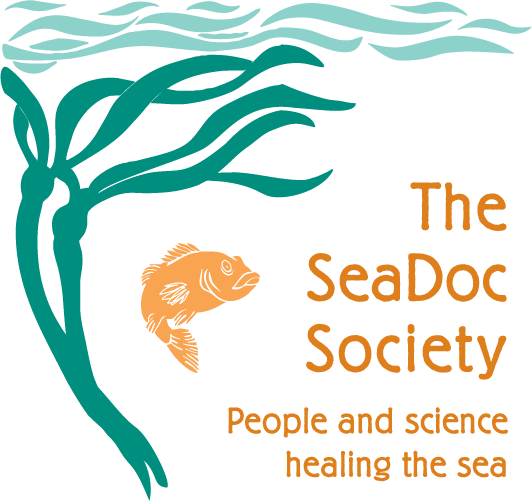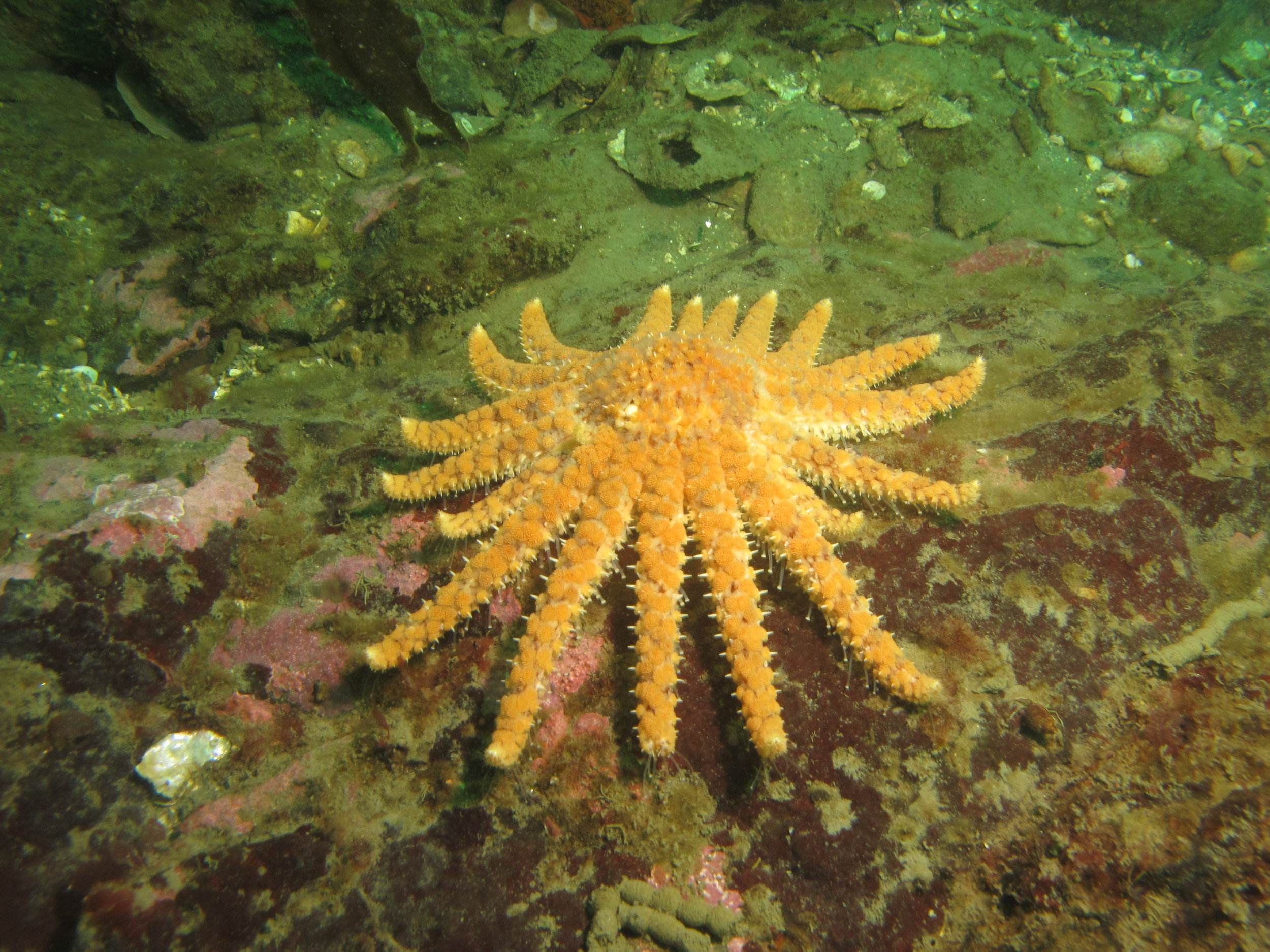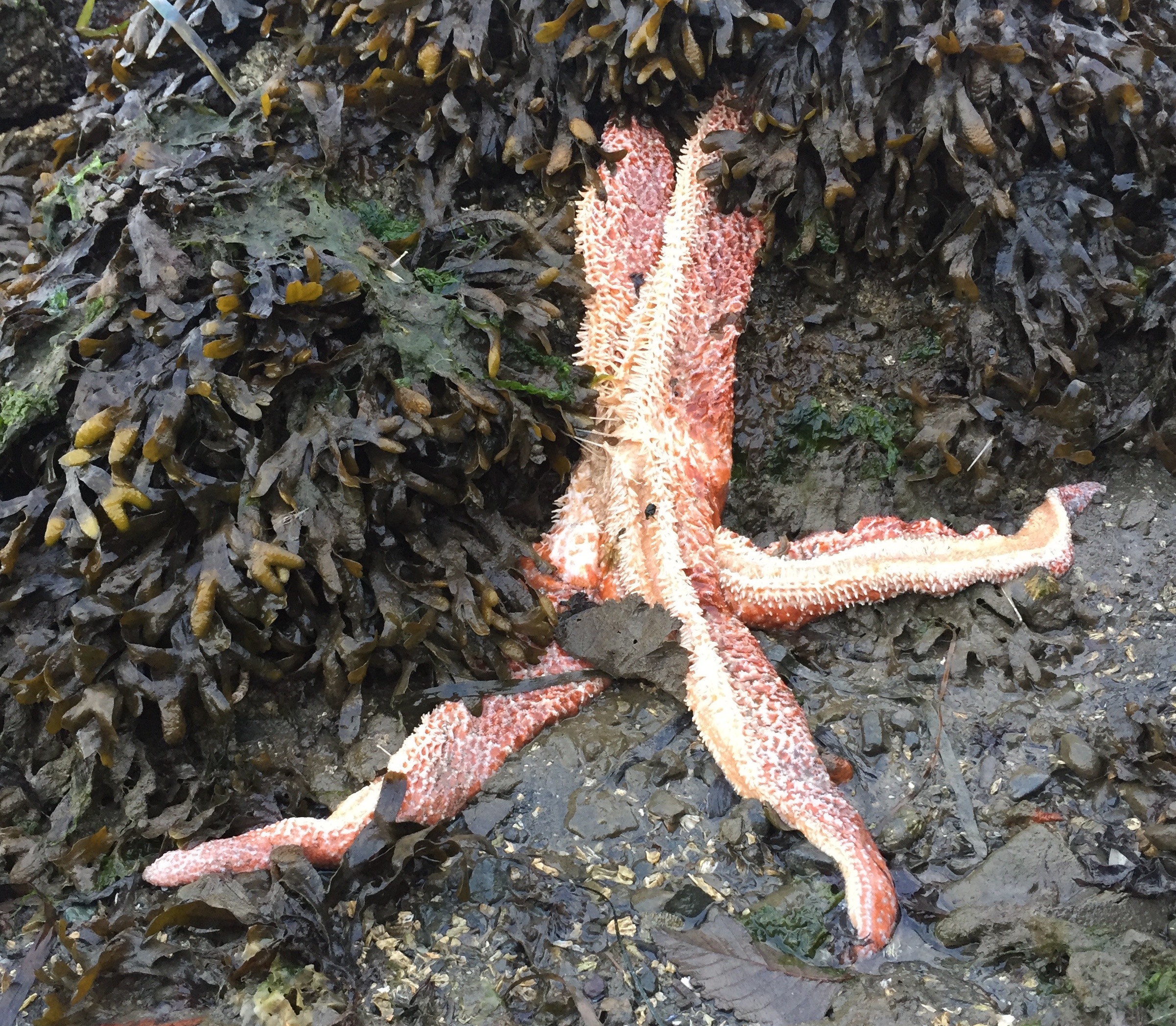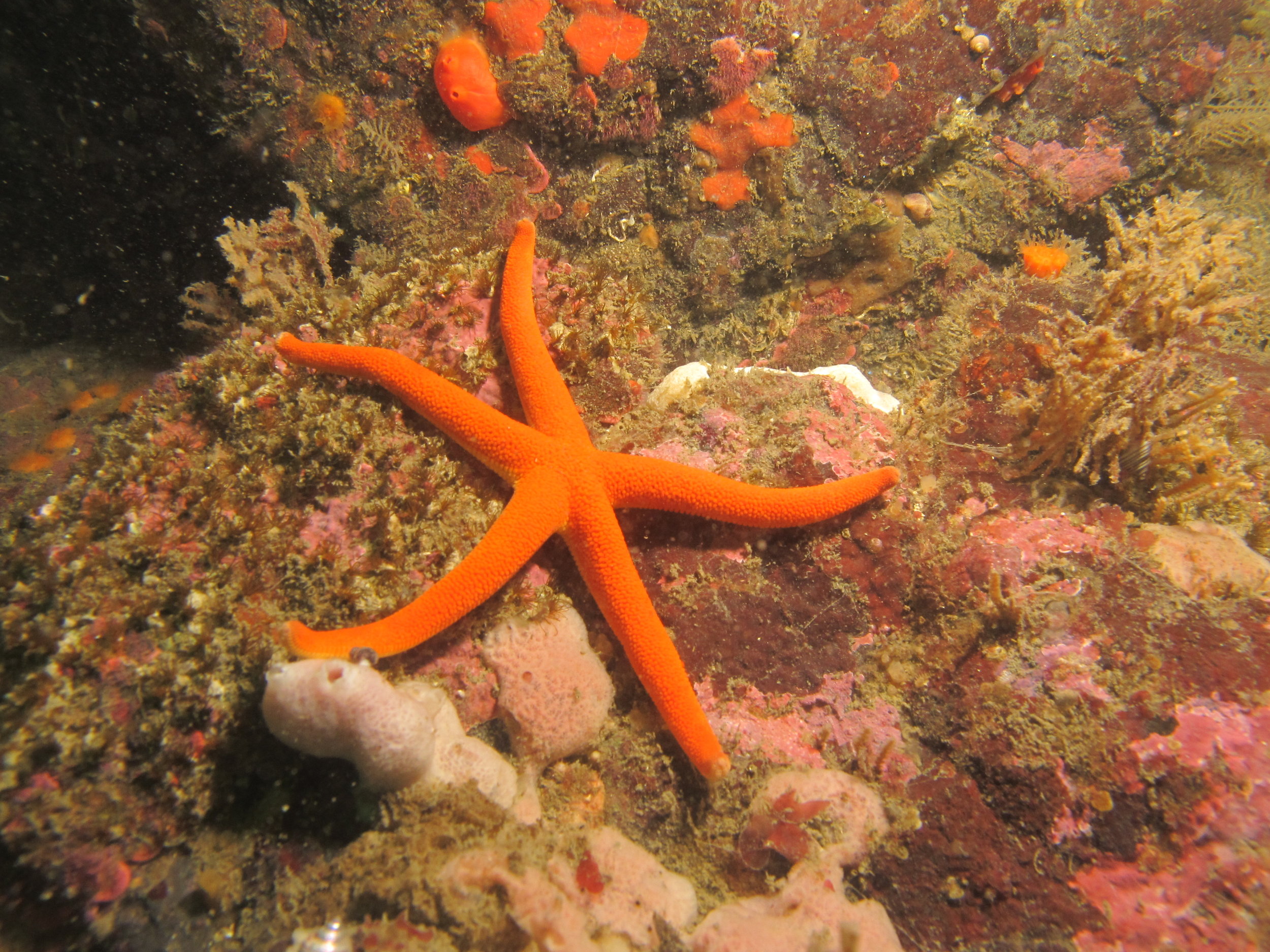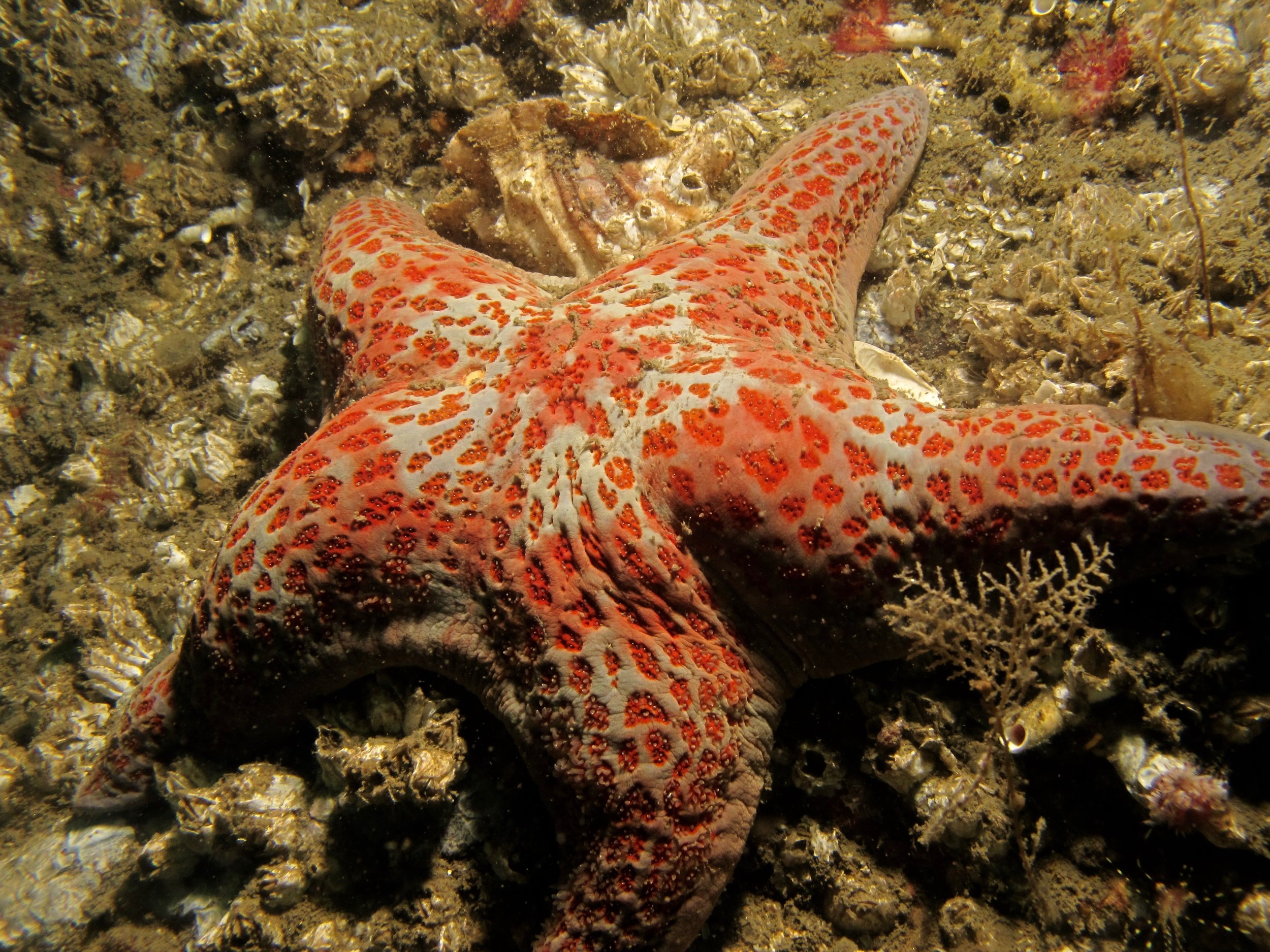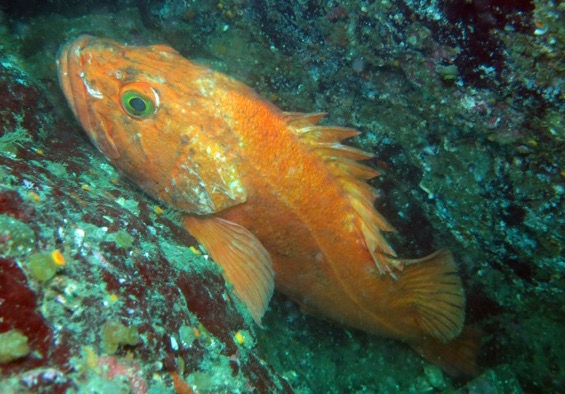I had the pleasure of sitting down with Markus Naugle, SeaDoc's new Regional Director, during his recent trip to the Karen C. Drayer Wildlife Health Center at UC Davis. We had a great conversation about his move to Orcas Island after 10 years of running an educational immersion program in Guatemala, as well as his new role at SeaDoc Society at a time when the organization is aiming to double its scientific impact in the Salish Sea. You can hear our conversation below!
So Much Opportunity for Citizen Scientists in the Salish Sea
By Bob Friel
Science CAN be a walk in the park.
Or a stroll on the beach. Or a dive in the sea.
From astronomy to zoology, there has never been as much opportunity for “regular” people to actively take part in science. Citizen scientists, data collectors with day jobs, retiree researchers, whatever you want to call them: folks without advanced degrees are out there every day doing invaluable work to advance science. And for anyone with a passion for the environment, our vibrant Salish Sea is the perfect place to join in.
BEACHING FOR THE BIRDS
Photo by COASST
“Science is a team sport,” says Julia Parrish, University of Washington professor and founder/director of COASST, the Coastal Observation and Seabird Survey Team. “Citizens are the boots on the ground, collecting information and sending it to scientists who do the analysis.”
Parrish says that the information collected by volunteers like her 800-plus COASSTers is “broad extent, fine grain and, when done right, high quality data that isn’t obtainable any other way.”
To make sure it’s done right, folks interested in COASST attend at least one day-long session where, in exchange for a $20 deposit and a promise to survey their chosen beach at least once a month, they’re given the training and tools to enable them to identify beach-cast birds (there’s an additional session for those also interested in collecting data on marine debris).
“COASST’s materials are very impressive,” says Markus Naugle, SeaDoc’s director and a brand-new COASSTer. “Using their intuitive field guide and measuring tools, you learn how to identify seabirds to family and possibly even down to species level based solely on finding parts—even just a foot or a wing—cast up on the beach.”
With our region recently suffering unusual mortality events involving Cassins and Rhinoceros auklets, data gathered on COASSTers’ scientific beach strolls have contributed vitally important baseline measurements of seabird health as well as useful information advancing many other conservation and resource management issues.
WHO YA GONNA CALL?
Photo by Bill Hoglund
Another citizen science program that gives you a reason to get to the beach is the Marine Mammal Stranding Network (MMSN), which is permitted by NOAA to respond to both live and dead strandings of seals, dolphins, whales, and all other animals managed under the Marine Mammal Protection Act.
“I LOVE volunteering with the stranding network!” says Erin Shackelford, a responder for the San Juan County chapter based out of the Whale Museum in Friday Harbor. “I get to work with a great group of people, it’s an incredible opportunity to learn about the environment up close, and when I respond to a call, I really feel as if I’m making a difference.”
Most of the stranding calls in the Salish Sea are for harbor seal pups that have either become separated from their mothers or washed ashore deceased. For live animals, volunteers monitor, tag, collect data, and sometimes, if they’ve been injured due to human contact, collect the pups for rehabilitation. “But even when the stranding involves a dead animal,” says Erin, “I know I’m helping to gather information that’s important to the health and future of the Salish Sea.”
In San Juan County, SeaDoc’s lead scientist Joe Gaydos performs necropsies on specimens collected by the stranding network. “The information we can gather from an animal that’s washed ashore,” says Joe, “whether it’s died from disease, malnourishment, entanglement, or any other reason, is critical to understanding what’s going on in the ecosystem. The stranding network is an invaluable resource.”
Data from the MMSN and its related necropsies have been used in many peer-reviewed studies—quite a few in partnership with SeaDoc, including the bizarre find of the first-known case of a harbor seal with equally developed conjoined twins, and another that investigated a murder mystery involving a Salish Sea serial killer!
Local chapters of the MMSN cover the entire Salish Sea (find yours here) and offer free training and yearly refreshers.
Counting Birds at Christmas
The longest-running citizen science program in the United States is the Audubon Society’s Christmas Bird Count (CBC), which started with 27 birders spotting 90 species on December 25, 1900. These days, tens of thousands of volunteers fan out within thousands of defined 15-mile diameter “count circles” to collect data that assesses the health and guides the conservation of hundreds of bird species. And now you don’t have to be an expert birder or miss unwrapping your presents to take part.
The “Christmas” bird count actually takes place anytime between December 14 and January 5 in order to collect status and trend data for the winter season. Each local circle is managed by an official Count Compiler (like Count Dracula, but for birds), who signs up volunteers and makes sure each group has at least one expert birdwatcher on hand.
The Environmental Protection Agency, US Fish & Wildlife, and others all use CBC data. Audubon itself used the crowd-sourced science in their disturbing 2014 report that predicts that 314 of the 588 North American species studied will lose more than half of their current climate range by 2080 due to climate change.
To find a circle near you and to join the next Christmas Bird Count, check out Audubon’s CBC site.
DOWN BELOW WHERE IT COUNTS
Photo by Pete Naylor
What began 27 years ago as a sort of Audubon Society for fish, REEF (Reef Environmental Education Foundation) has grown into one of the most respected participatory marine science programs in the world, with more than 213,000 underwater surveys completed by its sea of bubbling volunteers.
Chuck Curry, a long-time SeaDoc supporter from Bainbridge Island, WA, started scuba diving more than 30 years ago, but didn’t realize there was a way for him to combine his love of diving with his passionate support of science until he heard about REEF at a SeaDoc event in 2013.
“SeaDoc announced a partnership with REEF on a ten-year subtidal monitoring project that would use volunteer divers to collect the data,” says Chuck. His reaction was immediate: “I want to do that!”
Chuck joined REEF, began doing underwater surveys, quickly earned his expert rating in identifying Salish Sea fish and invertebrates, and now gets to work on that monitoring project. It was local REEF divers like Chuck that collected the baseline data and then served as the early warning system that alerted researchers to SSWD, Sea Star Wasting Disease. These citizen Cousteaus are also crucial to our ongoing efforts to identify the scope and severity of the outbreak.
“I appreciate how fortunate I am as a diver to see the marine environment firsthand,” says Chuck. “Doing REEF surveys not only helps me stay intimately connected to the Salish Sea, they also give me the opportunity to collect meaningful data for scientists working on conserving a place I love.”
This ethos of giving back is common in citizen science. We all have a stake in a healthy Salish Sea, and when in addition to supporting SeaDoc’s professional scientists you can also get out there and actively contribute to conservation, it can be even more gratifying.
As Julia Parrish of COASST says, “Volunteers are directly involved in collecting information about an ecosystem they’re connected to and want to know more about. This is experiential learning at its best! It deepens their connection and makes them advocate for the science that we do together. Who could ask for more than that?”
Banner photo courtesy of Bill Hoglund.
A New Science Advisor and the Science Behind the Salish Sea's Ancient Bonds
By Bob Friel
At the SeaDoc Society, we always talk about the importance of preserving the health of the Salish Sea for the benefit of both the environment as well as the people who live here and depend on it for everything from the economy and recreation to the philosophical satisfaction of existing amid such inspiring natural beauty.
SeaDoc’s newest addition to our all-star team of Science Advisors, Dr. Jamie Donatuto, understands that linking of people and place so deeply that she’s helped redefine the concept of ecosystem “health” for other scientists who’ve traditionally studied human and wildlife systems separately.
After earning her Environmental Science degree, Jamie went to work for the Swinomish Indian Tribal Community, a Tribe comprised of Coast Salish peoples who originally inhabited the Skagit and Samish River valleys, and Puget Sound coastline and islands.
“The Tribe asked me to write a project proposal to study toxics in locally-harvested shellfish,” says Jamie. It was an ideal project for her since she wanted to work in toxicology. And though it was her first try at writing a grant, not only was it accepted but also it was the largest grant ever awarded to a Native American tribe at that time.
Then, two years into her project, after completing the initial human health risk assessment, came the real beginning of Jamie’s education on ecosystem interconnectedness.
“I presented the draft results to the governing Tribal Council,” she says. “There was a long pause before the Chairman finally asked, ‘Where in these numbers are our definitions of health?’”
While Jamie and every other scientist working on issues like this had approached them by simply measuring potential poisons in the environment then describing human risk in biological terms of exposure to x micrograms of whatever toxins, the Swinomish had more profound ideas about defining and prioritizing health.
“Shellfish are an important traditional food for the Swinomish,” says Jamie. “But they taught me that the importance goes way beyond subsistence calories. For them, shellfish are imbued with deep connections to the health of their people through creation stories, ceremonies, tools, and the passing down of ancient ecological knowledge.”
It was an “Aha” moment for Jamie, who realized that the scientific tools available for human health assessment were inadequate to address the needs and values of tribal communities.
“I also found that in regards to health, scientists studied risks and impacts to natural ecosystems as if they existed in a wholly separate world from risks and impacts to human ecosystems.” This didn’t make sense to the Coast Salish or to Jamie. “Human and natural systems are inextricably connected and need to be assessed that way.”
Jamie realized that she’d have to create her own scientific study mechanisms, and used her revelations to inform her doctoral thesis: “When Seafood Feeds the Spirit Yet Poisons the Body: Developing Health Indicators for Risk Assessment in a Native American Fishing Community.”
It’s this kind of outstanding insight and experience that we prize in our SeaDoc science advisors, and we’re proud to now have Dr. Jamie Donatuto as part of the team.
Alongside her continuing work with the Swinomish Tribe, Jamie maintains her personal interconnectedness with the Salish Sea by swimming in it and hiking the trails on Orcas Island with her kids. And not only is she a high-flying environmental/social scientist, Jamie is also an aerial artist, performing acrobatic dance while suspended above the ground on a ribbon of silk!
Thanks for your continuing support, and please help us welcome Jamie aboard!
To see a list of all SeaDoc's Science Advisors, visit our Team page.
Shorebirds Share in Farm-to-Table Trend
By Bob Friel
Results from a recent SeaDoc Society-funded study show that agricultural lands adjacent to Puget Sound estuaries are surprisingly important sources of nutrients for over-wintering shorebirds.
Dunlins are busy little shorebirds you’ve probably seen probing and plucking along the shoreline. When their flocks are startled or attacked by a falcon, they erupt into a beautifully synchronized swarm that flashes and wheels above their feeding grounds.
The Dunlins natural winter habitats in the Salish Sea are the estuaries where our rivers meet and mix with the marine environment. These rich and complex ecosystems serve a crucial role for many birds that use them as refueling sites during long migrations—nature’s truck stops for shorebirds and ducks.
Unfortunately for the birds (and a lot of other wildlife), 75% of the tidal wetlands in Puget Sound river deltas have been lost due to human impacts like conversion to industrial areas and farmland. In this study, SeaDoc-funded scientists Keith Hobson (Environment Canada), Gary Slater (Ecostudies Institute), David Lank and Rachel Gardener (both Simon Frasier University), and Ruth Milner (Washington Department of Fish and Wildlife) looked at the Skagit and Stillaguamish River deltas. In both places, more than 85% of the wetland habitat has been converted to agriculture.
Dunlin feeding in uplands
So, with most of their former foraging area given over to raising grass and clover for cattle feed, what do the Dunlins eat to keep them alive during the winter and provide enough energy to continue their migrations to and from their breeding grounds on the arctic tundra?
No, they don’t go vegetarian and start eating clover—they’re strict carnivores—but as the research team from both Washington State and British Columbia discovered, the approximately 60,000 Dunlins that winter on the Skagit and Stillaguamish estuaries do make good use of the farmlands.
Scientists used mist nets to capture 171 Dunlins. They took blood samples and then used radio telemetry to track the birds’ habitat use. They also ground up samples of the shrimp, mollusks and other goodies the birds eat in the intact marshes and shorelines, and the juicy earthworms they can find on farmlands, and then used stable isotopes of carbon and nitrogen to measure where the Dunlins were getting their nutrients.
While it was clear that the Dunlins preferred the natural estuary, especially the tidal flats and low marshes, they obtained a significantly greater portion (62%) of their protein from the agricultural areas. The later it got in winter, the more the birds depended on the farms.
Does this mean we should turn all our natural estuaries into cropland? Of course not. We need to prevent the loss of a single additional acre of wetland, and to restore as much of it as possible so the estuaries can serve the many purposes they provide to a healthy ecosystem. In fact, estuaries are so important, the Puget Sound Partnership identified estuary restoration as one of their vital signs and goals for Puget Sound Restoration.
Splashing dunlin
What this study does show is that we need to be especially vigilant about letting any agricultural land adjacent to our estuaries get converted into usages like residential or commercial developments. The shorebirds may be able to hunt nightcrawlers on croplands, but they won’t find much to eat on parking lots.
This SeaDoc-funded science not only further proves the extreme interconnectedness of our terrestrial and marine environments, but at a practical level it will help inform future decisions about the management of lands surrounding our critical estuaries. Thank you for supporting science that makes a difference.
Banner photo caption: Dunlin eating in an estuary. Photos courtesy of Samantha Franks.
The Refuse-to-Use Water Bottle & Coffee Cup Challenge
In an effort to bring attention to the massive amount of paper and plastic waste we all produce in single-use beverage containers, The SeaDoc Society and the Orcas Exchange invite you to participate in the 2017 Refuse-To-Use Orcas Water Bottle & Coffee Cup Challenge!
It’s easy to play: Promise not use any single-use coffee cups or water bottles in 2017, and instead use your favorite reusable containers. Then try not to lose those containers ALL YEAR. Manage that, and win prizes from SeaDoc and The Exchange!*
Follow these steps to participate:
- Take a photo of your favorite reusable coffee cup, water bottle, or both (extra points for including a furry friend in the pic).
- Upload the photo to your Facebook page, tell your friends what you are up to, and challenge your friends to participate.
- Tag “The Exchange/ORS” or “The SeaDoc Society” and include the hash tag #RefuseToUseOrcas so we can keep track of entries.
- Make sure the privacy is set to “public” so we can see it, and then click “post.”
- Posts must be up by midnight, March 1, 2017.
- Next is the easy step—reuse your bottle and/or cup all year long!
- Between December 1, and December 15th 2017, follow the steps above, posting a new pic of your well-worn, well-traveled container(s) to complete the challenge. Final pics must be posted by Midnight, December 15th.
Only entries posted by midnight March 1, with subsequent December posting will be considered eligible for prizes. Winners and prizes will be announced at the end of December! To receive two cool, free stickers for your reusable container, sign up for the SeaDoc newsletter at www.SeaDocSociety.org.
- *Gifts are limited to residents of Orcas Island—but we hope this promotion goes viral! It beats dumping ice water on your head…
- What the gifts actually are has yet to be determined… but they will be super cool, not terribly valuable, and environmentally friendly!
- We realize there are lots of ways to game the system here so we are going to count on the honor system. We will check date stamps on image files, and compare the before-and-after pics to see if the containers match. ORS/SeaDoc retain the right to award or withhold prizes to anyone.
SeaDoc Adds to its All-Star Science Team
By Bob Friel
There’s a world of difference between West Africa and the Salish Sea, between the steamy equatorial jungle habitat of pygmy hippos and zebra duikers, and the Pacific Northwest’s temperate rainforests and chilly waters aswim with salmon and orcas. But Dr. Ken Currens, SeaDoc’s newest addition to our team of Science Advisors, has called both places home.
Ken Snow
Growing up amid Liberia’s remarkable biodiversity sparked Ken’s interest in conservation, an awareness that became a calling after moving to Oregon and earning his PhD in fisheries. Since coming to the shores of the Salish Sea in 1995, Ken has worked for the Northwest Indian Fisheries Commission (NWIFC), which is the natural resource management organization of Washington State’s 20 treaty tribes. Currently he serves as manager of the NWIFC's Conservation Planning Program.
Ken’s scientific specialties include phylogeography, a field combining genetic and spatial study that’s proved critical to Salish Sea salmon conservation and Endangered Species Act listings by determining which Evolutionary Significant Units (ESUs - a.k.a. stocks) are reproductively isolated by watersheds and seasonal runs. When he's not working, Ken takes full advantage of the region’s outdoor attractions and is an active mountain climber, skier, and fisherman.
Much of Ken’s scientific work has been precisely aligned with SeaDoc’s mandate to do great science and get it in the hands of managers and policy makers so they can make well-informed decisions. In addition to working for the Northwest Indian Fisheries Commission, Ken has also worked as Science Director for the Puget Sound Partnership (PSP) and has served on multiple endangered species recovery teams, science panels, and scientific journal editorial boards. He joins our team of advisors that have been chosen from the top scientists on both sides of the border to ensure our work has the greatest reach and effect possible on the welfare of the Salish Sea.
And SeaDoc’s scientific advisory board doesn’t just exist as degree-plastered window dressing! We count on all of these highly accomplished scientists to help us prioritize our research and review grant proposals from researchers seeking funding that we provide, with your support, through the SeaDoc Society Competitive Grants program.
Ken’s scientific background and expertise brings a valued new voice and a wealth of experience. “I’m thrilled,” says Ken, “to be working with one of the most effective small nonprofits supporting Salish Sea science and restoration.”
Please help us welcome him aboard the SeaDoc all-star science team!
Why do killer whales strand?
By Joe Gaydos
An 18-year-old southern resident killer whale (J34) was found dead on December 20th and necropsied the following day by representatives of the Vancouver Aquarium, Department of Fisheries and Oceans, local Sechelt First Nation community members, marine mammal field technician Mike deRoos and veterinary pathologist Dr. Stephen Raverty. Initial examination suggests blunt force trauma as the cause of death, though more tests still need to be performed.
Just 11 days later, the Center for Whale Research declared J2, Granny, to be officially missing from the southern resident killer whale population. Last seen by the Center on October 12, 2016, J2 is presumed to be dead.
What do we know about why killer whales die? Why are some found and other are not? A SeaDoc paper published by Dr. Michelle Barbieri and co-authors in the journal Marine Mammalogy showed that despite being one of the best studied marine mammal populations in the world, we only have a 1 in 5 chance of finding a southern resident killer whale that has died. The odds are even smaller for finding a dead northern resident killer whale (1 in 33). This tells us several important things.
Although sad, every stranded animal is a rare opportunity to learn as much as we can about these incredible animals. We were lucky J34 was found and reported by the Sechelt First Nation and fortunate that Dr. Raverty was able to perform the necropsy within 24 hours. We also are grateful that NOAA Fisheries (US) and Fisheries and Oceans Canada have made it a priority to better understand disease and mortality in killer whales. The rarity with which we find dead killer whales also reminds us that we need to study live animals as well as stranded animals to understand their threats well enough to save them.
SeaDoc is working with collaborators throughout the killer whale research community to develop an individual, animal-based health record keeping system so that one day we can be tallying whales saved rather than whales lost.
Serious Concern for Sunflower Sea Stars
By Bob Friel
Science usually happens a millimeter at a time. When looking at an animal population, for example, changes in abundance are often revealed in the data as a slight trend line amid cyclical ups and downs. But then there’s what’s happened to our sunflower sea stars.
Sea Star Wasting Disease (SSWD) has taken its deadly toll on at least 20 species of echinoderms. First noticed here in the Salish Sea in 2013, this current epidemic has since devastated starfish from Mexico to Alaska. In our region—a world-renowned hotspot for sea star diversity—the virus affects blood stars, giant pinks, morning sun stars, the beloved ochre sea star, and many others. None, though, have been hit as hard as the sunflower sea star.
When over 8,000 citizen-scuba diver surveys collected by REEF (Reef Environmental Education Foundation) were graphed to show sunflower counts, it didn’t show a shallow descending trend line. It literally traced the path of a falling star.
Actual 2006-15 and projected 2014-15 abundance for sunflower stars in 5 basins of the Salish Sea and the Outer Coast. Grey line marks the epidemic onset. Note: Figure taken from Dr. Diego Montecino-Latorre’s paper (2016)
The hope that deep waters below the divers’ range still held healthy populations that could act as a genetic reservoir was dashed when the Washington Department of Fish and Wildlife’s (WDFW) annual deepwater sampling trawls came up with similar results: the “near extirpation” of sunflower sea stars throughout the state’s inland waters.
The inescapable fact is that what was once the most commonly seen invertebrate in the Salish Sea has almost disappeared in just a few years.
Sunflowers are the magnificent beasts of the sea star world, with as many as 24 arms that from tip to tip can measure up to the size of a nine-year-old child. And they use those arms to chase down sea urchins as enthusiastically as a nine-year-old chasing down an ice cream truck on a hot summer day. Sunflower predation is such an important control on urchin populations (which left unchecked can raze kelp forests) that the sea stars are considered ecosystem engineers. Remove them from the picture and we’re likely facing a domino effect of negative outcomes for all kinds of plant and animal species. Evidence of such a “trophic cascade” is already being found by researchers in British Columbia.
SeaDoc and our partners at REEF, WDFW, Cornell University, Vancouver Aquarium, and the Seattle Aquarium, which brought together experts for an emergency scientific summit on SSWD a year ago, have been at ground zero of this epidemic from the start. And with such startlingly clear results from the science and such alarming potential for further damage to the ecosystem, we feel there’s no time to lose in moving forward quickly with sunflower sea star conservation.
Consequently, SeaDoc lead scientist Joe Gaydos, with help from multiple collaborators like REEF, WDFW, Cornell, SR3 Sealife Response, Rehabilitation and Research, and others, have submitted a proposal to NOAA National Marine Fisheries Service to list the sunflower sea star as a US Federal "species of concern.” This is NOAA’s proactive protection program, with the aim of evaluating threats and identifying research priorities for at-risk species in the hope they can be saved before having to be listed as threatened or endangered under the US Endangered Species Act.
The proposal for listing is currently being reviewed while SeaDoc and other scientists continue to try and understand the workings of sea star wasting disease, including studying how this massive marine disease outbreak will ultimately change the Salish Sea and other coastal marine ecosystems. Thanks to your support, SeaDoc is on the case.
Banner photo: wasting sunflower sea star. Photo courtesy of Jenn Collins.
Taking Care of the Little Things
By Bob Friel
Everybody loves the Salish Sea’s killer whales, playful porpoise, and puppy-like seals. Birders flock here to see such feathered favorites as rhinoceros auklets, tufted puffins, and marbled murrelets. And no fish anywhere is as exalted as our Chinook, the king salmon, appreciated as sport fish, table fare, and cultural icon.
But where’s the love for the sand lance? Who here is a herring hugger?
Forage fish are the Rodney Dangerfields of the sea—they get no respect. Even that catchall name for the many different species of small schooling fish suggests they exist only to serve as self-propelled snacks. However, without these little fish that feed at the base of the food web, converting plankton into silvery packets of energy, there wouldn’t be any of those other more charismatic critters. No auklets, no puffins, and no king salmon. And without king salmon, of course, the Southern Resident Killer Whales disappear.
It’s impossible to exaggerate the importance of forage fish to the overall health of the Salish Sea. Unfortunately the research and, where needed, recovery work on these vital species hasn’t been commensurate with their value. So SeaDoc is investing in forage fish by funding two new projects, one on sand lance and the other on herring.
With everything from seabirds to sea lions hunting them, Pacific sand lance (Ammodytes personatus) have evolved an ingenious survival strategy. Whenever they’re not grazing on plankton in the water column, they tuck themselves into the sandy seabed to hide from predators and wait for their next feeding opportunity.
We know that Pacific sand lance nourish myriad crucial Salish Sea species, and a recent Northwest Straits Initiative / SeaDoc study showed smaller sand lance are widely distributed in our near shore waters year round, with population peaks in the summer. But we still don’t know the answers to some basic questions about these fascinating little fish, such as: Where exactly do they like to hide? How many of them are there? And, are their populations stable?
Now, we’re funding a new project that will use underwater video and a bottom-biting oceanographic tool called a Van Veen Sampler to ascertain the exact types of sea floor where the sand lance prefer to bury (too silty and they can’t breathe; too gravelly and they can injure themselves while tunneling). Co-investigators Drs. Cliff Robinson (Pacific Wildlife Foundation / University of Victoria) and Doug Bertram (Environment and Climate Change Canada) and their team will precisely map those habitats, build an improved model for predicting seafloor use by sand lance, and re-sample study sites monthly to look at population health and seasonal variability.
Compared to our knowledge base on sand lance, we know quite a bit about Salish Sea herring. As the foundational forage fish—the energy source that spins a huge part of our food web—healthy herring populations are considered so critical that the Puget Sound Partnership lists them as one of our “vital signs.” Simply checking the dwindling numbers of many herring stocks on the Washington State side of the Salish Sea, tells you that the ecosystem is in trouble.
The herring stock that spawns at Cherry Point, site of the state’s largest oil refinery, was once the most prolific in all of Puget Sound. Since 1973, the Cherry Point population has crashed by more than 93 percent. While this stock and others on the U.S. side are faltering, in British Columbia's Strait of Georgia they’re currently booming. With your support, our research is designed to find out reasons why some stocks are hurting and how to recover them as soon as possible.
Helping herring will never be as sexy as salmon conservation, but it’s every bit as important to the health of our ecosystem. So SeaDoc is jumpstarting the recovery process for Puget Sound herring by funding a joint US / Canadian team co-led by Drs. Tessa Francis (Puget Sound Institute, UW Tacoma) and Dayv Lowry (WA Department of Fish and Wildlife) that will act as the nexus for relevant data and expertise. This project will determine the specific threats harming the southern herring populations, assess all of the stocks, and evaluate the state of the science, policies, and ongoing recovery efforts in order to ultimately produce a comprehensive Salish Sea herring conservation and management plan.
Thanks to your support, both new projects continue the SeaDoc Society’s mission to provide the science that’s helping to heal our Salish Sea.
This holiday season, show some love to the lowly forage fish. Go ahead: hug a herring.
Banner photo: Rhinocerus auklet with sand lance. Courtesy of Phil Green, from The Nature Conservancy.
SeaDoc Welcomes Markus Naugle!
By Bob Friel
SeaDoc’s mad scientists have been hard at work in the laboratory for nearly a year trying to animate someone to fill the new position of Regional Director by cobbling together cloned bits of biologists, entrepreneurs, non-profit experts, and ocean lovers. Joe “Dr. Moreau” Gaydos was just about to throw the big switch when in walked Markus Naugle with a resume that blew us away, putting an end to the experiments.
After earning his biology degree at MIT, Markus served for nearly a decade as a biotech management consultant, business analyst, and product manager for large international health care firms. He then co-founded, Magic Carpet Rides, a successful non-profit program in Guatemala dedicated to cultural immersion, service learning, and natural exploration.
Fitting with SeaDoc’s focus on fieldwork as well as lab and data studies, Markus is also an active outdoorsman, experienced world traveler, and ocean advocate. He was a scuba instructor on the Great Barrier Reef, helped restore a rainforest in New Zealand, and saved sea turtles in Costa Rica.
Topping it all off, Markus even has history in SeaDoc’s home waters. When he starts at our Orcas Island office in late November, it will be a homecoming to a place where he’s previously lived, dived, and been a valued member of the local community.
“It’s a thrill for my family and me to come home and join the SeaDoc team,” says Markus. “I am eager to use my skills and experience to help SeaDoc achieve its vital mission of healing our Salish Sea through science.”
Please join us in welcoming Markus to the SeaDoc team as we begin a new era for SeaDoc in which, thanks to your continued support, we’ll be able to greatly expand our important work.
Sea Star Troubles Run Deep
By Bob Friel
One of the largest marine wildlife disease epidemics ever known to science —Sea Star Wasting Disease (SSWD)—has not spared the Salish Sea. While the most visible effect of the epidemic so far has been the loss of thousands of ochre stars, the Crayola-colored shallow-water species that turn our tide pools into works of purple and orange art, SeaDoc has discovered that great ecological damage is happening in deeper water too.
Drawing on data from more than 8,000 REEF (Reef Environmental Education Foundation) surveys by trained scuba diving citizen scientists along with precise transect studies completed by certified scientific divers, we found that SSWD has decimated populations of the once abundant sunflower sea stars to the point they’re considered virtually extirpated throughout our inland sea.
The Salish Sea hosts a great galaxy of sea stars encompassing a remarkably diverse collection of species. Among those, the sunflower (Pycnopodia helianthoides) holds a special place. Familiar to crabbers who often found them stuffed inside their pots eating their bait, and to divers who commonly swam over bottoms literally crawling with them, before the epidemic began in 2013, sunflowers were the most abundant sea star found below the low-tide mark.
The majority of our sea stars are predators, but the sunflower is a carnivore on a whole other level of dominance. Huge, relatively fast, and with three octopuses’ worth of hydraulic-powered arms, it’s the sucker-footed Starasaurus rex of the subtidal kingdom. While most marine life—as well as drysuited divers—steer well clear of sea urchins and their long, prickly spines, the sunflower stars gobble them like candy and then spit out the spiky bits. It’s the loss of such a voracious urchin-eater that’s particularly disturbing when we consider SSWD’s effects on our local ecosystem.
Herbivorous urchins graze on algae. A previous marine epidemic that killed off urchin populations in Florida and the Caribbean allowed algae to overgrow corals and severely damage tropical reefs. In our temperate waters, the concern is the reverse happening: with fewer sea star predators around, the urchin numbers can explode like underwater locusts and decimate the algae, mowing down our vital kelp forests, leaving behind what are known as urchin barrens.
With kelp such a crucial source of food and habitat for so many other creatures, the worry is that the loss of sunflower sea stars, which we’ve learned are particularly susceptible to SSWD, could start a trophic cascade that negatively alters the Salish Sea ecosystem.
SeaDoc and our partners remain on the case as this epidemic continues to affect our waters. We’re continuing the basic critter-counting science that alerts us to changes in the environment, investigating the virus linked to SSWD, and trying to determine whether other environmental factors played a part in the outbreak. If it turns out that intervention is necessary, we’ll be there to provide the science critical to inform the decision-making.
- Read a PLOS One interview with Dr. Joe Gaydos about the study.
- Read the full publication.
Freeing Entangled Sea Lions from Discarded Human Trash
By Justin Cox
Surveys in British Columbia have documented hundreds of sea lions entangled by discarded human trash and derelict fishing gear, according to the Vancouver Aquarium. Similar numbers are estimated along the West Coast of the United States.
Wildlife Veterinarian and SeaDoc Director Dr. Joe Gaydos has been working with Dr. Marty Haulena, lead veterinarian at the Vancouver Aquarium, Kristin Wilkinson and others at NOAA Fisheries, and a team including other veterinarians, wildlife officials and biologists to bring this tool to Washington and Oregon.
On a recent trip to Bodeltah Islands off the coast of Washington, the team disentangled two affected sea lions, the first animals to be disentangled in Washington. After viewing multiple entangled animals, the team was able to identify several good candidates, sedate them, remove the packing straps that had entangled them, and then reverse the anesthetic and recover them safely.
“We’re excited to be bringing this safe, but technically challenging technique into Washington,” said Gaydos.” Disentanglement not only improves the welfare of the animals we help, but also enables us to collect data needed to identify the main items entangling sea lions so we can help manufacturers alter their production and stop the entanglement cycle.”
This work was done under the Marine Mammal Health and Stranding Response Program Permit #18786. Read more about the team’s work and check out more cool photos on the Aquarium’s Aquablog.
Banner photo: wildlife veterinarians Lesanna Lahner (Emerald Waters), Joe Gaydos (SeaDoc Society), and Martin Haulena (Vancouver Aquarium) work to disentangle an immobilized California sea lion (NMFS Permit #18786).
Bringing Back Rockfish
By Bob Friel
NOAA’s Draft Plan recommends actions to recover our endangered local rockfish
Photo of yelloweye rockfish by Ed Gullekson
Rockfish are remarkable animals. The genus includes 28 of the Salish Sea’s 253 fish species, and their slow-growing, late-maturing, long-living, stay-at-home lifestyle is ideally adapted to our deep, rugged underwater habitats. With cryptic coloration and poisonous spines helping to keep them safe from predators, adult rockfish also have a low natural mortality rate, allowing them plenty of time (some species live more than 100 years!) to grow into large, prodigious breeders.
Unfortunately, rockfish ran into a snag when humans came along. They’re easy to catch, taste delicious, and those same life strategies that make them so successful under natural conditions also make them very vulnerable to overfishing. The biggest, fattest, oldest fish that serve as the best babymakers are also the lunkers so highly prized by fishermen. Since the mid-60s, our overall rockfish population has crashed by 70%.
Wildlife managers recognized the problem decades ago and began attempts to halt the decline. SeaDoc has long been heavily involved with rockfish issues and we continue to work closely with recreational fishermen, charter guides, and scientists from our local tribes, universities, NGOs, and all levels of government on both sides of the border in order to provide the best science possible to inform management decisions.
After looking at the science, thirteen rockfish were listed as Species of Concern by Washington State, which enacted commercial and recreation fishing bans. In British Columbia, the government set aside Rockfish Conservation Areas (RCAs). At the U.S. federal level, the big guns were pulled out in 2010 when three species of Salish Sea rockfish—yelloweye, Boccaccio, and canary—were listed under the Endangered Species Act. DNA research has since shown that our canary rockfish are part of the same population as the coastal canaries so they’ll likely be removed from ESA protection, but our yelloweye (Sebastes ruberrimus) and Boccaccio (Sebastes paucispinis) Distinct Population Segments remain listed, respectively, as threatened and endangered.
Canary rockfish photo by NOAA.
ESA listing requires NOAA Fisheries to come up with a plan to keep the affected species from going extinct. Drawing on studies (by SeaDoc and many others), they’ve come up with a Draft Rockfish Recovery Plan. The plan includes about 45 recommended actions, including doing a lot more research to better understand the rockfishes’ critical life stages (see our monthly update where divers are finding YOYs) as well as the threats they’re facing such as death by accidental bycatch and derelict fishing gear, water quality problems like persistent organic pollutants and low oxygen levels, and habitat issues including kelp restoration.
While all the stakeholders agree they want to see the return of healthy rockfish populations, if there’s one aspect of the plan sure to be a hot-button issue, it’s the call to start the separate public process for creating RCAs, MPAs (Marine Protected Areas), or some other form of marine reserves in the San Juan Islands and eastern Strait of Juan de Fuca where NOAA has identified a high risk of rockfish bycatch.
Marine reserves have been shown to help fish populations, especially with long-lived, resident species like rockfish, but some recreational fishermen believe the regulations already in effect do enough to protect the yelloweye and Boccaccio.
What do you think? NOAA wants to hear from you, and you can comment on their plan here until November 14. Along with taking comments, NOAA will be holding public meetings on the rockfish plan (more information and meeting schedule here). To arm yourself with all the info before you comment or attend a meeting, settle back, put your fins up and dive into the complete 157-page plan and its 83 pages of implementation appendices. It’s interesting reading, and chock full of facts about rockfish and their Salish Sea habitat.
SeaDoc and REEF Divers Hit the Jackpot
Video by Janna Nichols
By Bob Friel
Video by Janna Nichols
For a full week this September, the underwater rock walls and kelp forests of the San Juan Islands swarmed with clipboard-carrying scuba divers taking part in an annual study co-sponsored by SeaDoc and The Reef Environmental Education Foundation (REEF).
Among all the fish and invertebrates encountered during 100 survey dives, the drysuited citizen scientists and expert critter counters were blown away by how many YOYs they found. Young-of-the-Year, or YOY, is marine biology speak for baby fish, and what the dive teams saw weren’t just any old fingerlings, but juvenile yellowtail and black rockfish.
“I’ve never seen so many YOY rockfish in the San Juans,” says Janna Nichols, REEF Outreach Coordinator and veteran of 1,300 Salish Sea dives. Last year, surveyors saw a few rockfish fry on about one of every eight dives. This year they seemed to be everywhere and, reports Nichols, “There were hundreds of them.”
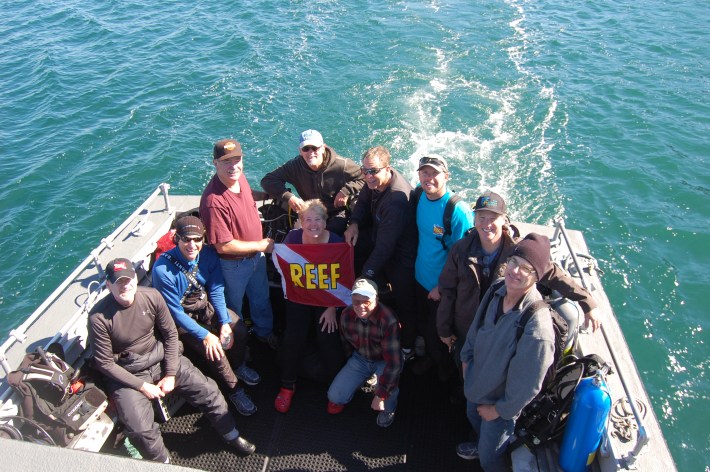
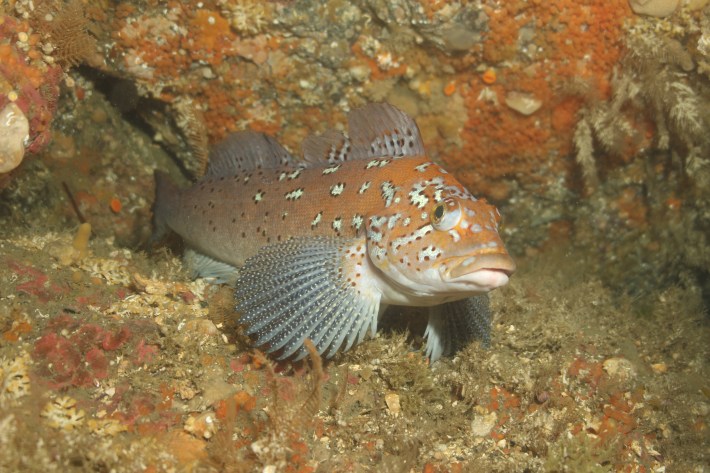

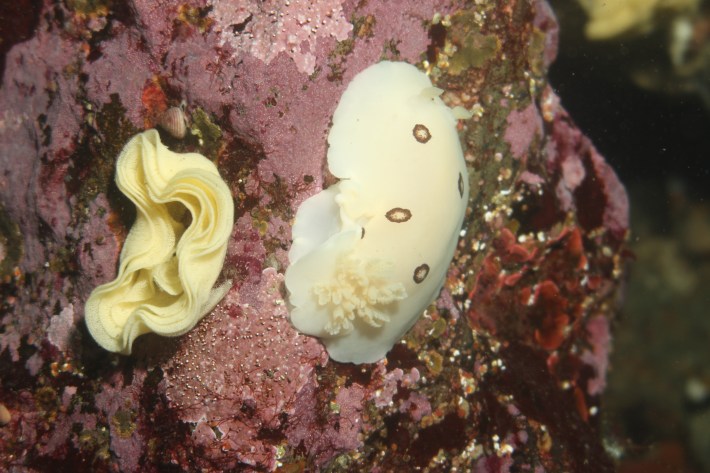
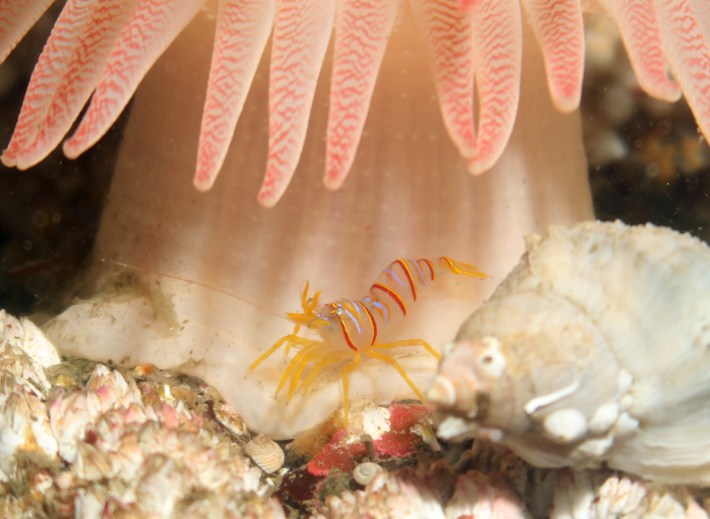
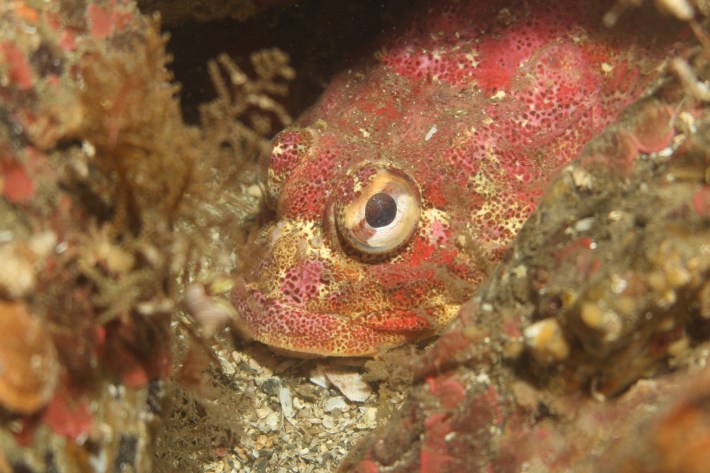
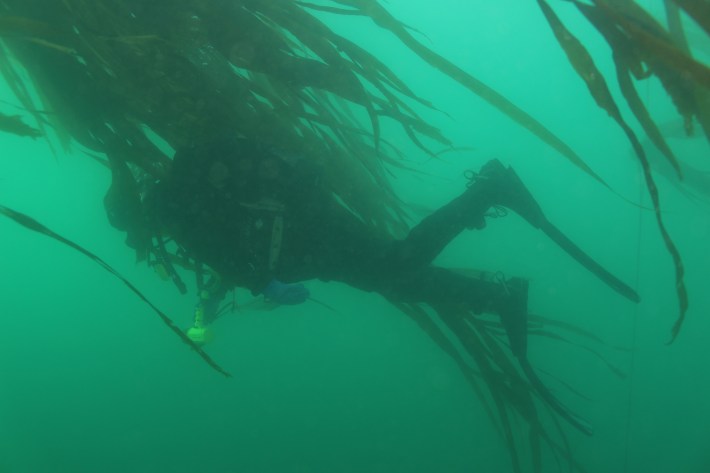
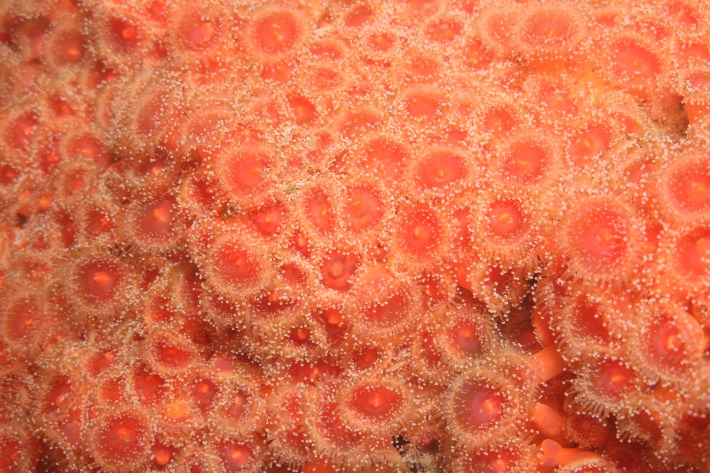
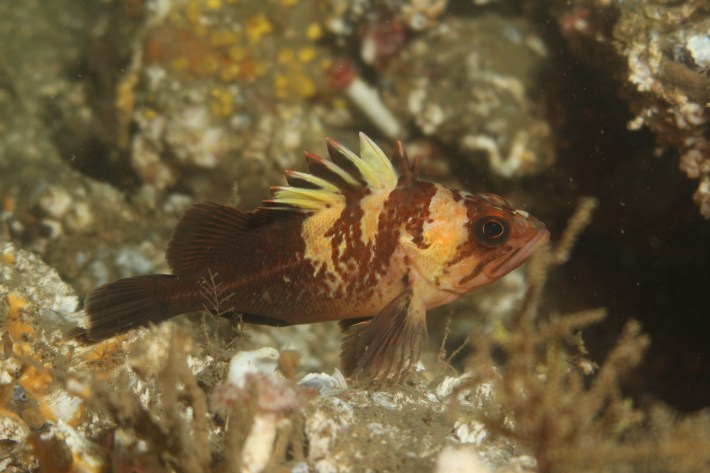

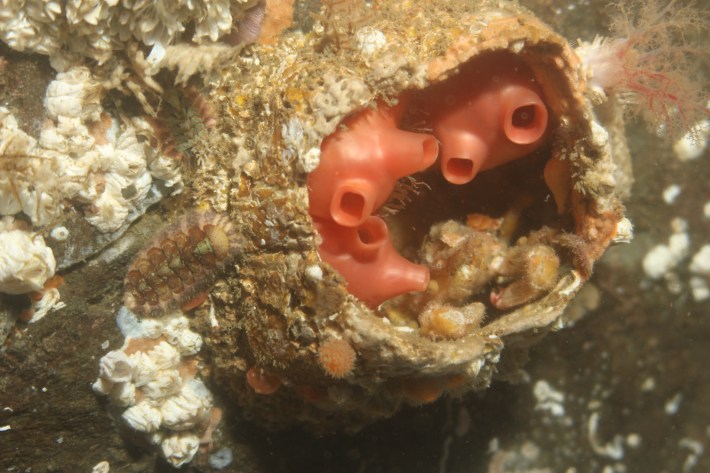
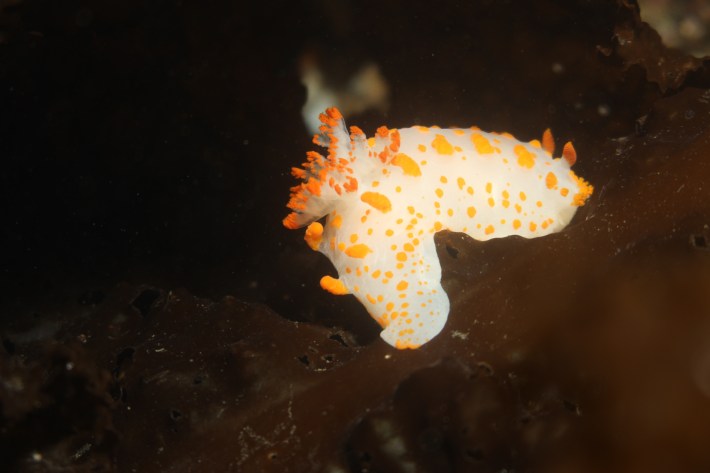
Photos by Janna Nichols
Rockfish baby booms, called “jackpot recruitment events,” happen sporadically and likely only when water temperature, climate, predator abundance, and other conditions are just right. Researchers haven’t yet been able to correlate jackpot events to subsequent increases in adult fish populations, but with our Salish Sea rockfish populations on the ropes from overfishing, the more babies they pump out the better.
Rockfish grow so slow that this year’s yellowtail jackpot juvies will need to dodge predators and derelict fishing gear for at least the next five years (six to eight years for black rockfish) before they’ll mature and get big enough to breed. However, with new fishing regulations in place to protect them, this current class of recruits should have a better chance at long lives than previous generations. “It will be interesting to see over the next couple of years of surveying if these little guys survive,” says Nichols.
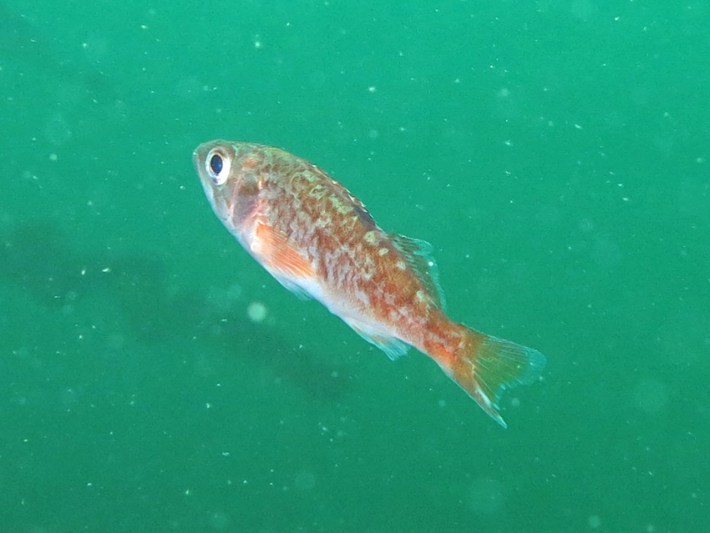
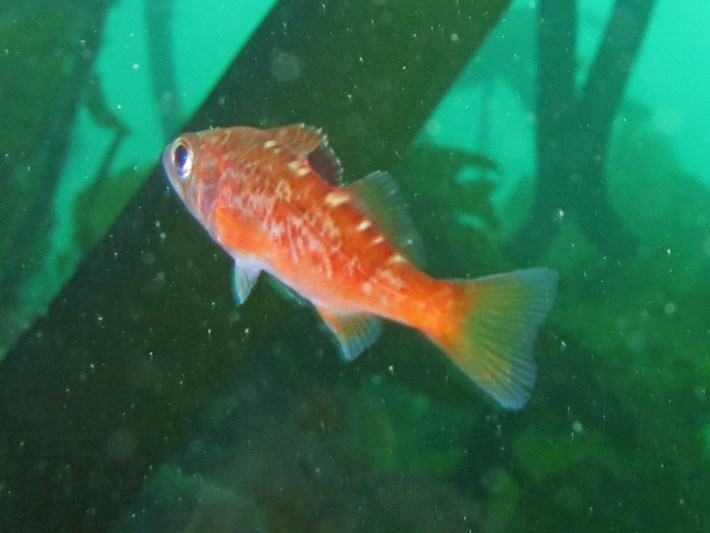
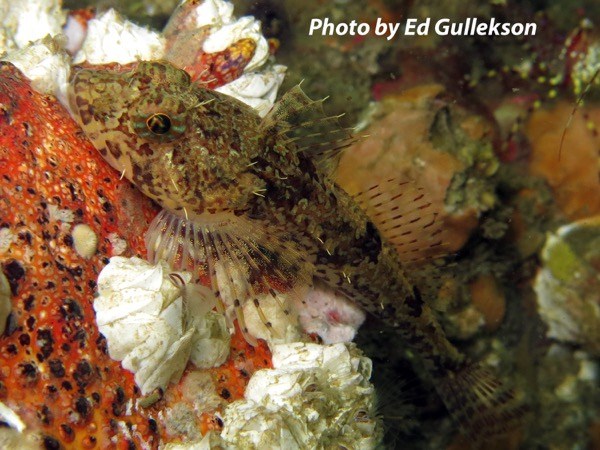
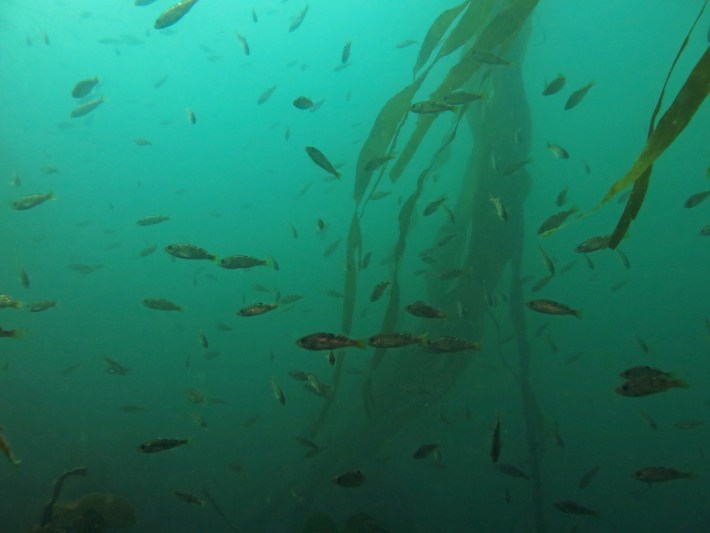
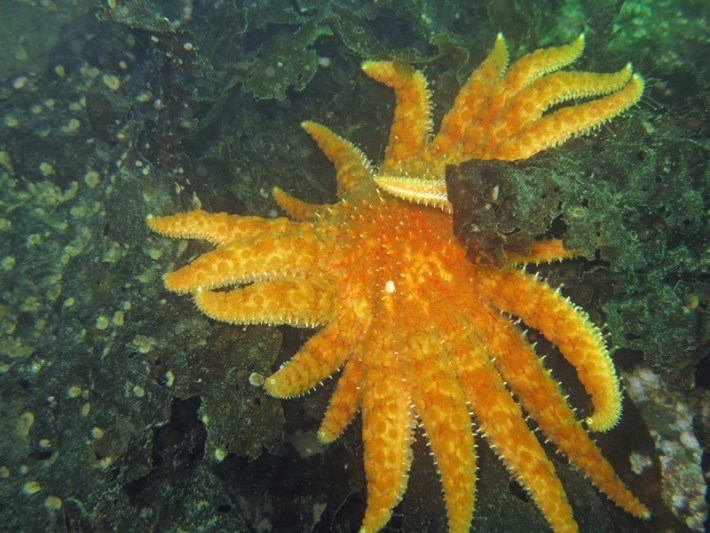
Photos by Ed Gullekson
Aside from the annual intensive San Juan Islands monitoring study, SeaDoc collects data year-round on the fish and invertebrates we find on our Salish Sea underwater sites. We remain very active in rockfish conservation, and we’ll continue to document their abundance levels and, hopefully, their recovery.
If you’re a diver or snorkeler, you can help out by telling us about the rockfish you see (what kinds, where, and how many). Or better yet, join REEF (www.reef.org), the fish-watcher’s version of the Audubon Society. It's free and you can start doing survey dives right away. Free web-based ID classes are available too - it’s a great way to hone your ID skills, and together with REEF’s 50,000 citizen scientists you’ll be helping to track the health of our marine ecosystems. Plus, diving here in the beautiful waters of the Salish Sea, it’s just a matter of time before you’ll hit the jackpot.
SeaDoc Operates on the Cutting Edge to Track Waterbirds
By Bob Friel
Of all the recent changes in the Salish Sea ecosystem, one of the most visible is the virtual disappearance of the Western grebe. Our inland sea was once the preferred winter habitat for 70% of the entire population of this stately black-and-white waterbird with its swanlike neck and devilish red eyes. Today, though, after summering on lakes and wetlands where they perform one of the earth’s most spectacular mating rituals and raise their chicks on floating nests, only about 4% of Western grebes return to spend the cooler months in Salish Sea waters.
Over the last 20 years, the population size of grebes has fallen across their range, with some of the culprits for this being oil spills in California’s marine waters where a large population of grebes spends the winter, as well as pollution and other human impacts on the grebes’ freshwater breeding grounds. However, these factors don’t fully explain the dramatic 90% drop in the Salish Sea winter population.
A prior groundbreaking SeaDoc seabird study showed that the Salish Sea’s specialized hunters—sushi lovers like loons, scoters, and grebes—were all being hit hard by declines in high-quality forage fish like herring. That’s another major piece of information, but still doesn’t complete the puzzle. For that we’ll need to ask the grebes themselves by tracking them so precisely that they tell us what’s going on with the changes in their populations and migratory patterns.
Scientists today have all kinds of cool tech tools to help track wildlife. But while suction-cupping a GPS transmitter to a blue whale has no effect on the 200-ton beast, it’s much more taxing to strap any external device on a four-pound waterbird that not only has to retain the aerodynamics to fly, but also the hydrodynamics and waterproofing needed to dive, swim, and catch fish.
Enter the bionic bird.
The idea of implanting a small telemetry device inside a bird’s body cavity is not new. It had even been tried before with grebes. Unfortunately, that experiment had disastrous consequences for every one of the test subjects. Paging SeaDoc to the operating room, stat!
Across two recent studies, SeaDoc veterinarians, in collaboration with other wildlife veterinarians from the UC Davis Oiled Wildlife Care Network and USGS, as well as biologists from Washington and California's Departments of Fish and Wildlife, first made sure the improved surgery worked in captivity. (Read the study). They then used the revolutionized surgical methods on grebes captured in the San Francisco Bay.
As a proof of concept it was a great success, with an 89% survival rate for the first 25 days after release. (Read the most recent study). Two grebes continued broadcasting data for more than 14 months until their transmitter batteries died. We tracked one of those birds across 2,144 kilometers as it summered in Oregon before returning to the Bay Area—the first roundtrip migration of a Western grebe ever recorded in real time!
While we have no plans to create flocks of bionic birds, our studies achieved a big leap forward in wildlife surgical techniques and, with continued improvement, should assist in providing enough future tracking data to inform decisions about habitat protection and pollution mitigation that we hope will help recover our Western grebe populations.
Banner photo: Western grebe with implanted satellite transmitter. Courtesy of Joe Gaydos.
Something to Spout About
By Bob Friel
Photo by Bob Friel
All of the Salish Sea’s marine mammals—from sea otters to orcas, pinnipeds to porpoises and all the great whales—are federally protected. In collaboration with The Whale Museum, SeaDoc makes crucial contributions to conserving these animals by tracking and diagnosing their diseases, and by responding when they turn up stranded on the beach.
This year, the Whale Museum/SeaDoc partnership was among only three entities in Washington State awarded federal funding under the John H. Prescott Marine Mammal Rescue Assistance Grant Program. These funds will allow us to continue to respond to marine mammal strandings and to do the research necessary to establish what causes them to end up stranded in the first place.
In the past, SeaDoc, the Whale Museum, and a whole cadre of volunteers have worked to unravel mysteries associated with the impact of Navy sonar on whales, to determine whether zoonotic diseases like brucellosis that effect seals also pose a risk to humans, and to gather other data critical to marine mammal conservation.
Teamwork in research and wildlife rescue activities increases our effectiveness, while success at raising public funds to supplement private support allows SeaDoc to expand our mission to restore the Salish Sea. And it’s all good news for marine mammals!
Release the Canaries?
By Bob Friel and Joe Gaydos
A school of Canary Rockfish. Photo by NOAA’s National Ocean Service.
The National Marine Fisheries Service has proposed to delist the Puget Sound / Georgia Basin Canary Rockfish (Sebastes pinniger) from the list of threatened species under the US Endangered Species Act. The delisting isn’t based on an increase in the Rockfish population, but on the results of recent genetic findings that show our local canaries are genetically the same as those living on the Washington coast and that they’re not, as previously thought, a Distinct Population Segment (DPS). Incidentally, Canary Rockfish on the Pacific Coast were considered overfished in 2000 and thanks to a rebuilding plan, were determined to be "rebuilt" in 2015.
Similar testing showed that Yelloweye Rockfish (S. ruberrimus) within the Salish Sea are different from those on the coast and thus form a DPS. Not enough Boccacio (S. paucispinis) could be sampled to determine if it is a DPS. Since both Yelloweye and Boccaccio Rockfish remain protected under the ESA, delisting canaries will have no effect on the stringent fishing regulations put in place to try and recover all our local Rockfish species.
After reviewing the supplementary scientific information provided by NOAA, SeaDoc submitted a formal comment in support of this decision (acknowledging that the science supports the decisions being made). Comments are due Sept. 6, 2016. Click here to read the details of the science behind this proposed rule change and/or to submit a formal comment.
Large Whale Disentanglement Training
By Bob Friel
A whale rescue team aboard SeaDoc’s research boat Molly B takes part in an entanglement training scenario. Photo by Bob Friel.
For the Salish Sea, 2016 has been the Summer of the Humpback. Normally we see a small handful of humpback whales hang around all season, with others passing through in spring and fall, but this year more than 70 of the huge, pickle-faced cetaceans spent the entire summer feeding and frolicking in local waters.
While the number of big whales is a boon for whale watchers because our endangered Southern Resident Killer Whales have been forced to roam far and wide in search of fewer and fewer salmon, it’s also drawn attention to how we, as a region, are woefully unprepared to handle some of the issues that accompany burgeoning populations of large whales.
California has seen a similar increase in humpbacks showing up inshore, which is where the whales come into contact with fishing gear. Entangled as they swim through lobster lines or when curious calves get caught up playing with crab floats, the whales are liable to get wrapped in super strong synthetic lines that hinder their swimming, anchor them to the bottom, or even slice their tails off.
On the East Coast, half the humpback population shows scars from run-ins with manmade obstacles. And since the Salish Sea’s summertime whale influx coincides with the laying of gillnets and many miles of line connected to crab and shrimp pots, it’s likely only a matter of time before we wind up with a snared humpback or, even worse, a tangled resident orca.
In order to begin assembling a team prepared to respond to large whales in trouble, SeaDoc and Whale Museum staff joined local Marine Mammal Stranding Network volunteers and officials from NOAA for a full day of training on how to document and evaluate these dangerous situations. The group then ran on-water scenarios using a Washington Fish & Wildlife boat as stand-in for a 40-ton entangled humpback. Trainees practiced throwing special grappling hooks to snare trailing lines and attached telemetry buoys to track the "whale" by satellite and VHF.
This was just the first step in getting ready for problems we hope we never see but must be prepared for. For now, sighting and documenting issues is the priority, and it’s something everyone can be involved in. So while you’re enjoying watching our local whales, keep an eye out for any that appear entangled or seem in distress. If you spot something, keep your required distance (100 yards for humpbacks; 200 yards for resident orcas) but get photos or video, and call the hotline at: 877-SOS-WHALE.
Video: SeaDoc in High-Definition
By Bob Friel
Using a high-definition “Deep Blue” camera and special face masks, SeaDoc divers can feed live video and narration to topside audiences who get to enjoy all the underwater action while staying warm and dry.
SeaDoc has performed these extremely popular “virtual dives” for several years using borrowed video gear, but thanks to a generous donation from the Benedict Family Foundation, we now have our own upgraded camera equipment that we’ve modified to better showcase and record marine creatures big and small. The next step is to acquire the capability to stream our virtual dives over the internet to reach even larger audiences for education, research, and fundraising opportunities.
If you think you have the right setting—waterfront home, marina, or large boat—and an audience that wants to support SeaDoc’s work and see the wonders beneath the Salish Sea without getting wet, ask us about organizing a virtual dive.
Underwater video by Bob Friel
Riddle of the Rhinos
By Bob Friel
Rhinoceros Aucklet. Photo by Joe Gaydos.
Were they poisoned by harmful algae? Did they get outcompeted by an increasing humpback whale population? Or is a warming ocean shifting their food supply? Aided by citizen scientists on both sides of the border, researchers are trying to figure out why Rhinoceros Auklets—the unicorns of the seabird world—are washing up dead in unusually large numbers this year around their most important Salish Sea breeding colony.
There’s been concern in recent years about food supplies for diving birds like auklets and other puffins. Observations from Protection Island in the Strait of Juan de Fuca show that breeding success of the 72,000 Rhinos nesting there was about half normal levels. And trained beach surveyors from the Coastal Observation and Seabird Survey Team (COASST) discovered as many as 100 times the number of dead Rhinos they’d expect to find in an average July. So what’s going on?
Necropsies fingered both starvation and pneumonia, but there’s not enough data to know which came first: sickness or lack of food. Stay tuned for the results.
Interested in being a part of citizen science seabird survey work? Become a COASST volunteer. SeaDoc feels so strongly about the work of COASST we helped fund their expansion into the San Juan Islands in 2001. Sign up at their website.
